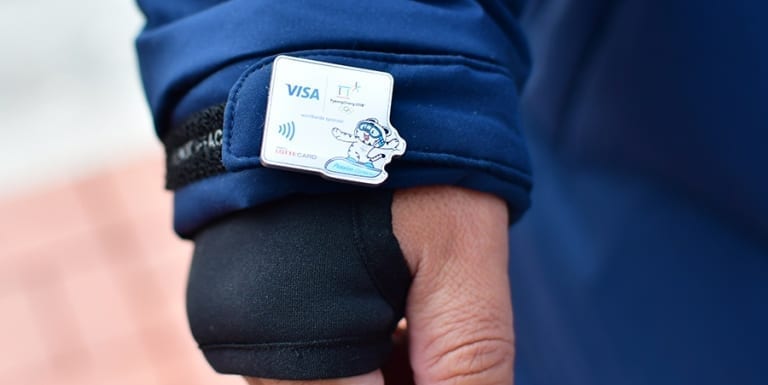
All eyes are on whether “wearable credit cards,” which became a hit during the 2018 Winter Olympics in PyeongChang in South Korea, will be able to gain ground in the domestic market even after the closing ceremony of the Olympics. In the United Kingdom and Australia, the wearable card market is already being established.
According to credit industry sources on March 20, Lotte Card Co. predicted earlier that 100,000 wearable payment devices for the 2018 PyeongChang Winter Olympics would be sold. However, more than 150,000 wearable payment devices have been sold as of the 18th of this month.
Visa has developed three Near Field Communication (NFC)-enabled wearable payment products for the Winter Olympics: A commemorative sticker, a pair of gloves, and an Olympic pin in November last year. Visa teamed up with Lotte Card, the financial arm of the South Korean-based retail giant Lotte Department Store to produce these new pre-paid payment wearables. To use the devices, the wearer can tap or bring the wearable near any NFC-enabled terminal or reader and the secured microchip and antenna embedded within the device will allow a contactless payment to be completed.
Credit card companies are paying attention to whether wearable credit cards will be able to sustain the momentum from the Winter Olympics and create the market in South Korea.
Foreign major financial companies and payment and settlement companies have been already preparing for various types of payment services, including wearable credit cards, in order to dominate the future payment market in advance. U.K.-based Barclaycard joined hands with numerous accessory brands to develop NFC-enabled wearable payment products, such as bracelets, smartphone cases and keychains. Australia’s Bankwest also launched ‘Halo’, a ring that enables users to make ‘tap and go’ payments as an alternative to cash or a contactless card. The ring itself is water-resistant and does not need to be charged. In addition, The “Pay per Gaze” payment service using Google Glass also was released.
However, there are big challenges for the wearable payment market due to no standards established for contactless payments and compatibility with other devices. In fact, some users had trouble making a payment during the Winter Olympics when they put their NFC-enabled commemorative sticker on the center or the upper side of their smartphones. This is because it conflicted with their smartphone’s NFC features.
An official from the credit card industry said, “Commercialization of wearable credit cards is not too distant when we solve problems with technology verification and complementarities with wearable types of cards.”